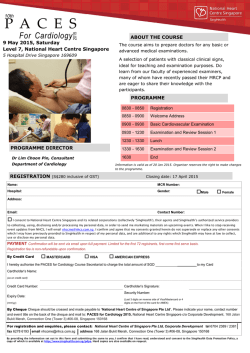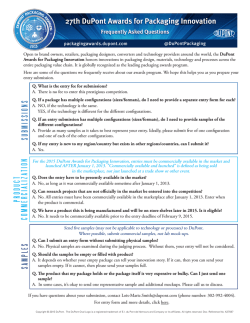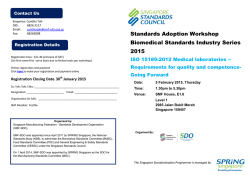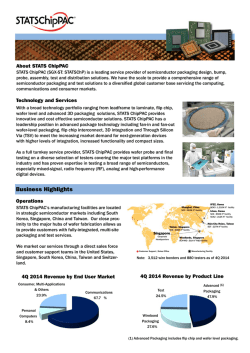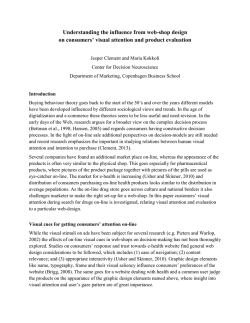
PERSPECTIVES - January 2015 - IMRE
JANUARY 2015 Research, Development and Commercialisation MCI (P) 045/03/2014 • ISSN 0219-1830 Institute of Materials Research and Engineering www.imre.a-star.edu.sg CORPORATE NEWS RESEARCH ‘Smart’ packaging that extends shelflife and reduces food wastage AWARDS Nanoscale in 3D PEOPLE President’s Science Award 2014 UPCOMING EVENTS OUTREACH Profile – Experience counts for a lot Seminars and workshops to look out for! IMRE-LION Workshop CORPORATE NEWS Materials to help you transform your ideas into creative solutions and sharpen your company’s edge in 2015! 2014 was a year of collaborations. Since its establishment, IMRE has built a comprehensive suite of technical accomplishments. In recent years, we have gained momentum in terms of furthering our interactions with industry and forming effective and strategic partnerships. At the beginning of the year, we launched the new Materials Centre of Innovation (MCOI) together with SPRING Singapore. The Materials COI works side-by-side with SMEs by providing solutions and new products that SMEs can use commercially. Our industry-themed IMRE Nanoimprint Foundry also continues to help develop specially engineered plastics and surfaces for commercialising nanoimprint technology. By translating IMRE’s competencies to industrial applications, we give SMEs the flexibility to adapt quicker in today’s fast-growing technology environment. Japanese consumer giant, LION Corporation, also signed its first Research Collaboration Agreement (RCA) in Singapore, with IMRE, to conduct joint research to develop environmentally friendly household products. We partnered with local construction company, SunHuan Construction Pte Ltd, to deploy advanced phase change materials to cool its new ‘green’ building. IMRE will continue to lay the groundwork for the foundation of our industry relevant R&D partnerships to grow our industry engagement. And as we look forward to 2015, I would like to thank all our partners and stakeholders for their continued support and wish them an abundance of happiness, health and prosperity in 2015. ‘Smart’ packaging that extends shelf-life and reduces food wastage IMRE has invented a new active plastic packaging that is as good as metalised packaging, but at only 20 percent of its cost. The new packaging can also be coupled with other IMRE technologies like a sensor that can accurately indicate the freshness of packaged meat, fish or poultry. The new packaging was recently announced during the launch of the second phase of the IMRE-led industry consortium on coatings and packaging. help detect minute chemical concentrations associated with the freshness of meat, fish or poultry to give a more accurate indication of food spoilage and expiration. The phase two of the consortium, which was launched on 17 November 2014, will further explore, develop, advance and test new materials for food packaging. The researchers at IMRE are also working to adapt the packaging material to applications in other areas like electronics and medical packaging. For more information on the research, please contact Dr Li Xu [email protected] What is the Industrial Coating And Packaging (ICAP) consoritum? The Industrial Coating And Packaging (ICAP) consortium is a platform that helps companies reduce R&D risks and investments in new coating and packaging technologies by synergistically pooling R&D resources in precompetitive projects. The signatories representing the new members of the consortium, and senior staff of IMRE at the ICAP phase two signing ceremony. I MRE recently signed an agreement with key industry partners to develop and test a new packaging material for industry use. The companies which have come onboard are Mitsui Chemicals Asia Pacific, Ltd (Japan), Toyo Ink SC Holdings Co., Ltd (Japan), Dai Nippon Printing Co., Ltd (Japan), Piaget Chemicals & Manufacturing Pte Ltd (Singapore) and Dou Yee Enterprises (S) Pte Ltd (Singapore). The compa- nies are part of the IMRE-led Industrial Coatings and Packaging (ICAP) consortium. Dr Li Xu, the principal scientist leading the R&D said, “We want to develop a protective plastic that is as effective as metallised plastic films in the market, but at 20 percent lower cost.” “Improvements to mundane materials like the plastic wrapping in your local supermarket are often taken for The new plastic packaging material (left) is as good as metallised plastic films but costs 20 percent less, can be used for a variety of perishables to extend shelf-life (middle). The packaging can be coupled with other IMRE technology like a ‘freshness’ sensor (right) that can tell more accurately when meat goes bad. granted but technology proves that such innovations could significantly change the world we live in,” said Prof Andy Hor, Executive Director of IMRE. “Our new material will help reduce food wastage considerably, and allow consumers to more accurately identify when food actually spoils.” The newly developed packing plastic incorporates nanotechnology that is based on non-toxic ferric compounds. The plastic also has a unique dual purpose high-barrier plate silicate sheet, which effectively blocks moisture and oxygen from seeping into the packaging, and scavenges oxygen to create an anaerobic environment that makes perishables last longer than they would in regular plastic packaging. IMRE has also developed a sensor strip that can Benefits of joining ICAP Pool Resources – Synergistic pooling of R&D resources to achieve common goal by reducing R&D risks and investments. Access to Advanced R&D – Access to advanced coating technologies and packaging technologies in a platform conducive for solving technical and fundamental problems at the pre-competitive level. Competitive Advantage – The latest in coating and packaging technologies enhances core competencies and competitive advantage. Networking – The consortium creates technology and business networking opportunities with the coating and packaging industry value chain. Institute of Materials Research and Engineering (IMRE) • A*STAR • Singapore • Institute of Materials Research and Engineering (IMRE) • A*STAR • Singapore • Institute of Materials Research and Engineering (IMRE) • A*STAR • Singapore • Institute Page 01 Institute of Materials Research and Engineering CORPORATE NEWS PEOPLE Profile – Experience counts for a lot Review, evaluate and plan for the future Dr Ramam Akkipeddi is no stranger to industry networking and collaborations having engaged and worked with many of IMRE’s partners as a senior scientist who has helped build IMRE’s infrastructure in micro-fabrication and materials characterisation for over 15 years. How does his new role as Head, Industry Alliance sync with what he has done? We find out from the man himself. What is your role as Head, Industry What are your immediate plans as Do you have a wishlist? Alliance? Head, Industry Alliance and how I hope to encourage IMRE to put Translational and application oriented can IMRE gain from this? more emphasis on translational pursuits are directions in which IMRE is We have begun organising networking work, by initiating more applica- now putting greater emphasis on. The sessions, with thematic presentations tion-oriented projects, which would creation of an Industry Alliance platform on topics related to IMRE’s strengths to then naturally call for good science, adds further momentum to this move industry. We also organise “technical scope for new technologies and in- by linking up with the stakeholders clinics” where partners can approach dustry involvement. I would also like regularly to communicate the materials IMRE specialists with technical issues to see corporate laboratories and knowledge and demonstrate the tech- in hand, so that we can work together other entities consider IMRE not nologies developed in IMRE. Thus, my to develop solutions or provide advice. only as a vibrant organization, with At IMRE, it is important to integrate in- high-calibre scientific knowledge in formation on the cluster of industries the materials arena, but also an in- aligned to IMRE’s thrust areas. These stitute known for its impactful and approaches can help engage industry disruptive technologies. Members of the External Review Committee and IMRE representatives holding discussions about IMRE’s future plans for research and technological developments. role is to think of new ways to promote I by encouraging prototyping, either in- MRE was host to members of the SERC External Review Committee (ERC) who were here to review research carried out in A*STAR’s Science and Engineering Research Council (SERC) research institutes. Prof Sir Keith O’nions, Chairman of Cambridge Enterprise and former President and Rector of Imperial College London, Dr Kazuo Murano, Former Chairman, Fujitsu Labs, Mr Bruce Brown, Former CTO,P&G, Prof Harold G. Craighead, Jr. Prof of Engineering, School of Applied and Engineering Physics, Cornell University, Prof Sukekatsu Ushioda, President, National Institute for Materials Science and Mr Jon Brodd, Founder & CEO, Cima NanoTech were invited to review and evaluate IMRE’s research and technological development plans. The ERC was established to help shape the agenda of the SERC research institutes going forward and to position them to take maximum advantage of future opportunities. PEOPLE Welcome to IMRE! and exhibit our capabilities to industry, house or by working with our partners, so that it draws interest from industry. in multi-party R&D sharing and economies of scale, and encourage the for- Was the switch from research to an mation of consortia or collaborative industry-related role a difficult one? projects in domains of IMRE’s strengths. Over the past 10 years, I have enjoyed Did your work as a scientist in IMRE managing the nanofabrication and ma- prepare you for this role? terials characterisation platform, with a clear mission of rendering consultancy services to industry. This gave me ample opportunities to regularly interact with the industry. I have always wanted to take up an advisory or a scientific ad- My “hands-on” research experience has helped me to a great extent in acclimatising to the needs of and to better engage industry, based on my accumulated technical understanding. My 30 years of background in electronic materials has ministrator role in an organisation, as I also facilitated my knowledge on themes enjoy communicating and sharing my like materials growth, device fabrication experiences with my peers. After putting and material characterisation, which have in years of research activities, I now see been very useful to me in understanding a great opportunity to grow the industry the fundamental technical needs of in- engagement further and facilitate IMRE dustry so that we can better address the research units in advancing active indus- over-arching challenges that they face. try collaborations. RESEARCH Publication Highlights New active film for effective marine antifouling Sreenivasa Reddy Puniredd, Dominik Jańczewski, Dewi Pitrasari Go, Xiaoying Zhu, Shifeng Guo, Serena Lay Ming Teo, Serina Siew Chen Lee and G. Julius Vancso; “Imprinting of metal receptors into multilayer polyelectrolyte films: Fabrication and applications in marine antifouling”; Chem. Sci., 2015, 6, 372-383 Left to Right (Clockwise): KUANG Jinghao (PF), DING Guoqiang (SI), HUANG Xiaohu (DG), HE Jiating (SI), ZHU Qiang (SI), LIU Zhennan (SI), Afriyanti SUMBOJA (SI) Not in photograph: TEO Yanru Gladys (IDM) Our New Learned Colleagues Masters / Bachelors; 13% 5 1 4 3 5 2 PhD; 87% 1 0 4 1 1 1 1 1 5 Europe Americas Asia Singapore 1 lyl amine to create an efficient antifouling surface and to improve the performance of antifouling paints. How: Antifouling paints reduce hull fouling because LbL films with the concept of imprinting and non - imprinting they contain copper, approaches and their saturation isotherms of copper loading among other metand antifouling performance against cyprids. als such as zinc and What: Researchers from IMRE have nickel. Copper is a heavy metal that developed an imidazole containing is toxic to marine invertebrates afpeptide, such as L-histidine methyl fecting their reproduction, growth, ester, bound to metal ions that can and abundance. It is also a pollutant be used in an active antifouling film. in the marine environment, espeThe active film is grafted on polyalcially close to docks and harbours, The imidazole containing biocide peptide, grafted on polycation to bind metals, shows promise as an alternative antifouling agent... because it leaches from the hulls of boats into the surrounding water. The research team used the very efficient imidazole containing peptides, such as L-histidine methyl ester grafted on polyallyl amine to construct thin layer by layer (LbL) architectures with high affinity to bind Cu2+ ions. Enhanced binding ability is achieved Institute of Materials Research and Engineering RESEARCH through a metal imprinting process involving covalent immobilisation of receptors within the film structure in presence of metal ions. Highly crosslinking density groups of methyl esters in the polyanion, can overcome the stability issues of the thin films generally encounters. This is a feature of particular interest in attempts to develop an efficient antifouling surface and improved stability of the films and are highly stable in sea salts environments for prolonged periods, and the copper leaching rate is very slow, for about 90 days, suggesting opportunities to use this covalent cross-linking approach to design functional imprinted films for antifouling and many other applications. Why: Designing and fabricating new, effective and environmentally friendly coating systems as alternatives to tributyltin (TBT) based antifouling paints is important. The imidazole containing biocide peptide, grafted on polycation to bind metals, shows promise as an alternative antifouling agent, that effectively protects against fouling of barnacles and other marine organisms, and is also less damaging to the environment than existing formulations. The technology can also benefit metal extraction processes, for example, in the water purification or natural resources recovery industries. For more information about the publication, please contact Dr Sreenivasa Reddy Puniredd [email protected]. edu.sg Nanoscale in 3D Researchers fromIMRE, NUS, andSUTD inSingapore havedeveloped a new approach to printing microscopic stereograms in full colour. The team has created possibly the smallest ever stereogram that does not require the viewer to don special glasses, but creates the 3D effect when viewed through an optical microscope. Using ‘biaxial’ nanostructures, the team engineered polarisation-sensitive ‘plasmonic pixels’ that change colour depending on the polarisation of light illuminating it, allowing the first demonstration of a three-dimensional (3D) plasmonic stereoscopic colour microprint. To print these 3D images, a layer of hydrogen silsesquioxane was spun on a silicon wafer surface and patterned with a series of holes defined by electron beam lithography. After post-processing, the remaining nano-pillars are capped with aluminium, forming an array of plasmonic pixels. Central to the colour creation are ‘plasmon resonances’, produced when light hits the thin aluminium layer to interact with the pixels. Each pixel produces a colour, determined by the nanostructure size or shape and the spacing between adjacent nanostructures. By employing ellipses or closelyspaced squares, a different interaction occurs when the pixel is illuminated, where each pixel produces a different colour under each polarisation. A full-colour ‘dual image’ can then be created by arranging the pixels in a desired pattern; each image only revealed to the observer under the design polarisation. Stereograms typically comprise two sideby-side images viewed separately by the left and right eye to create the illusion of depth. Examples include red and green prints that reconstruct 3D objects when viewed with a pair of red and green glasses. Here, stereograms were formed using a fade-free colour printing method, which also enables multiple colour microprints to be printed and viewed within the same area without using red and green filters. Moreover, compared to laser printers which print images using droplets of ink spaced about Steering light along tiny golden bead strings A. Teulle, M. Bosman, C. Girard, K. L. Gurunatha, M. Li, S. Mann, E. Dujardin; “Multimodal Plasmonics in Fused Colloidal Networks”; Nature Materials, 2014, DOI: 10.1038/NMAT4114 microscopy. Large networks of gold particles with diameters of only ~10 nm were made using the chemical expertise at CEMES (see A network of gold beads, each 10 nm in diameter. From left image). These long to right, this network is 750 nm long. The colours around the network show where different light energies are localised. Blue bead strings were represents 0.38 eV, red 0.70 eV and green 0.89 eV of energy. The then carefully fused energy map and network image were obtained using electron microscopy. together and measured in Singapore. What: A multidisciplinary team of It was shown that these networks IMRE and CEMES scientists have form pathways along which the light demonstrated that long chains and energy can travel in the form of ‘surnetworks of gold nanoparticles can face plasmons’. be used to confine light energy and The sizes of the networks can vary guide it over long distances. In an from very small (containing only a article published in the journal, Nafew dozen beads) to lengths of sevture Materials, the team of researcheral micrometers. The colours on the ers applied a recently developed chain indicate locations where light technique called ‘monochromated of different colours are concentratSTEM EELS’, which can observe optied. The distance from left to right cal phenomena with unprecedented was about 750 nm, which itself is detail. only one hundredth the width of a How: The behaviour of light at human hair. nanometer length scales is imposWhy: The work opens up the possible to observe with light microsibility to control light energy and its scopes, which is why the researchers used monochromated electron travel distance by tuning the shape The work opens up the possibility to control light energy and its travel distance by tuning the shape and size of the bead string networks. and size of the bead string networks. The findings in this work show that different colours of light are concentrated at specific points in the networks. In a larger effort to further miniaturise and speed-up functional circuits, these networks should prove very useful, since it has now been demonstrated that light energy can be addressed and accessed at specific nodes in these miniaturised optical networks. For more information about the publication, please contact Dr Michel Bosman [email protected]. edu.sg Reference table for quick estimation of concentration and size of nanosilver D. Paramelle, A. Sadovoy, S. Gorelik, P. Free, J. Hobley and D. G. Fernig; “A rapid method to estimate the concentration of citrate capped silver nanoparticles from UV-visible light spectra”; Analyst, 2014, 139, 4855-4861 Optical microprints of a square and cross printed onto the same area formed from (a) ellipses; (b) coupled nanosquare pixels illuminated under x and y-polarised light. (c) SEM image of boxed region in (b). Nanosquares of the same size and gap widths are separated by the dotted lines. (d) Overlaid images decoupled by polarisers. Scale bar: 20 μm. (e) Overlay of images in (d) forms a stereoscopic image with depth perception. (f) SEM image of boxed region in (e). Scale bar: 1 μm. 20 micrometers apart, this approach shrinks the separation to 400 nanometers - roughly 50 times smaller than its commercial counterparts to produce an ultra-high resolution print of 62,500 dpi. The research was published in the journal Nature Communications. For more information about the research, please contact Dr Goh Xiao Ming [email protected] or refer to the following publication: Xiao Ming Goh, Yihan Zheng, Shawn. J. Tan, Lei Zhang, Karthik Kumar, Cheng-Wei Qiu, Joel K.W. Yang; “Three-dimensional Plasmonic Stereoscopic Prints in Full Colour”; Nature Communications, 5, 2014, Article number 5361. The spectral control and polarisation-sensitive encoding capability of these pixels may enable application in colour displays, data storage and anti-counterfeiting technologies. What: One of the limitations to the use of silver nanoparticles is an easy method to calculate concentrations, to allow non-destructive analysis. Current methods could for example, require the use of expensive and time consuming equipment such as ICP-MS. With the creation of the table, it is possible to obtain a good concentration estimate using just a UV-vis spectrometer, and the research community could conduct easier and more productive research with silver nanoparticles. The developed methods are also applicable to other types of nanoparticles or structures. How: IMRE scientists have created a standardised table of extinction coefficient data for silver nanoparticles, which allows for easy and quick estimation of the concentration and size of modified and mono-dispersed silver nanoparticles from their optical spectra. The data was obtained by determining the silver content of citrate - stabilised silver nanoparticles, using sodium cyanide-mediated etching. Quantification of silver ion concentration enabled the calculation of extinction coefficients. In this case, experimentally calculated extinction coefficients are in good agree- Calculation of silver nanoparticle concentration. The extinction coefficient of citrate coated nanoparticles can be calculated using the table and the diameter of the nanoparticles estimated by λmax or by TEM. ...the research community could conduct easier and more productive research with silver nanoparticles. ment with collated literature values. The results are also in good agreement with the theoretical calculations using Mie theory. have great potential for vivo applications. Silver nanoparticles also have antimicrobial properties, and as such the use of ‘nanosilver’ has in recent years been popularised in consumer products. Current and future applications include, their use in clothing, fabrics, personal care/health products, and antimicrobial surfaces. For more information about the publication, please contact Why: Silver nanoparticles, much like gold, have become popular for applications such as in vitro diagnosis, and Dr Paul Francis Free [email protected]. Scan here for past issues of PERSPECTIVES OR Visit our website www.imre.a-star.edu.sg For general enquiries please write in to [email protected] Page 03 Institute of Materials Research and Engineering AWARDS OUTREACH Visits and Events IMRE-LION Workshop 01 Oct 2014 IMRE organised a workshop with LION that featured experts from both organisations. The workshop included seminars that provided insights into the advancements of materials used in consumables. The objective of the workshop was to introduce the various research activities conducted in LION and IMRE, and to foster as well as further develop existing collaborations. IMRE adjunct scientist, Prof Ho Ghim Wei, was honored with the L’Oréal Singapore For Women in Science National Fellowship for Physical & Engineering Sciences. The award was for her efforts in the research and education of nanomaterials science and engineering. One of LION’s representatives giving a seminar on the design and development of eye drops. 5th IMRE Scientific Research Forum: Nanofabrication & Surface Modification Shawn was selected as one of the 10 innovators from Southeast Asia, Australia and New Zealand, whose superb technical work ranks among the state-of-the-art scientific and technological innovations in the region. Dr Shah Kwok Wei, an IMRE scientist, received a commendation at the IET Innovation Awards 2014. He was nominated under the ‘Built Environment’ category, for his work on phase change materials (PCM), a ‘smart’ technology that helps cool buildings by absorbing heat during the day and releasing it at night. 02 – 03 Oct 2014 IMRE’s fifth annual Scientific Forum centered on the theme “Nanofabrication and Surface Modification”. The over 100 featured posters accompanied a variety of seminars presented by IMRE scientists on subjects such as thermoelectrics and plasmonic nanostructures. The research seminars were followed by technology development talks from A*STAR’s commercialisation arm, ETPL, and IMRE spin-off companies such as Tera Barrier and Sofshell. The forum was successfully organised by this year’s IMRE Scientific Research Forum committee, chaired by Dr Anton Sadovoy. An IMRE researcher explains her research on biomarker detections during the poster presentations. MCOI presents: “Sustainable Active Packaging and Functional 3D Printing Technologies” Seminar 29 Oct 2014 Prof Loh Kian Ping, an IMRE adjunct scientist, was awarded the prestigious President’s Science Award 2014 for his outstanding work on graphene chemistry at the President’s Science and Technology Awards 2014 ceremony. The Materials Centre of Innovation (MCOI), together with Singapore Logistics Association (SLA), Singapore Plastics Industry Association (SPIA) and Singapore Chemical Industry Council (SCIC), organised the “Sustainable Active Packaging and Functional 3D Printing Technologies” seminar. The event presented the latest developments in sustainable packaging materials and 3D printing technologies from IMRE. The seminar also served as a platform for industry participants to explore various potential applications of IMRE’s innovative materials in their products. Industry participants were given a glimpse of IMRE’s research facilities by Dr Pan Jisheng. The Next Generation Carbon Fibre and Future Demand for Composites and Carbon Fibres Seminar 18 Nov 2014 With its customised artificial cell membrane, IMRE’s spin-off, ACM Biolabs, will be able to help pharmaceutical and biomedical companies do away with live cells, thus, significantly lowering the cost of drug research. UPCOMING EVENTS Diary of upcoming events @ IMRE 28 Jan 2015 5th ASEAN event series “Bridges - Dialogues Towards a Culture of Peace” For more information and registration, please scan the QR code 03-05 Aug 2015 5th M3 @ Singapore Theme: The Next 50 years of Materials Research (in commemoration with SG50) For more information, please scan the QR code To find out more about IMRE’s seminars and events, please visit www.imre.a-star.edu.sg/eventsall.php IMRE invited Prof Andrew Walker, CEO of the Composites Centre at University of Manchester, UK , to give a seminar on the future development and demand of composites and carbon fibres in the automotive, aerospace and construction industry. The seminar included talks on re-evaluating modern material requirements of new products, and tailoring the next generation of carbon fibre to keep up with the increasing demands of such materials. Prof Walker discussing with invited industry participants on future research opportunities of carbon fibres. Global Innovation Imperatives (Gii) Event in Singapore: WITS Forum 2014 03 – 05 Dec 2014 IMRE hosted the inaugural Global Innovation Imperatives (Gii) event, which was organised by the Singapore National Institute of Chemistry (SNIC) and the American Chemical Society (ACS). This year, Gii focused on Water Treatment, through the Water Innovation Treatment & Solutions (WITS) forum. The forum included talks on global water resources development and management that were presented by key leaders of industry, universities and agencies. It was concluded by a roundtable meeting on the draft of the whitepaper on “Global Challenges, Local Solutions”. Prof Ellene Tratras Contis, the co-chair of the forum, addressing issues of water treatment and innovation at the forum. Institute of Materials Research and Engineering (IMRE) • A*STAR • Singapore • Institute of Materials Research and Engineering (IMRE) • A*STAR • Singapore • Institute of Materials Research and Engineering (IMRE) • A*STAR • Singapore • Institute Page 04
© Copyright 2026
